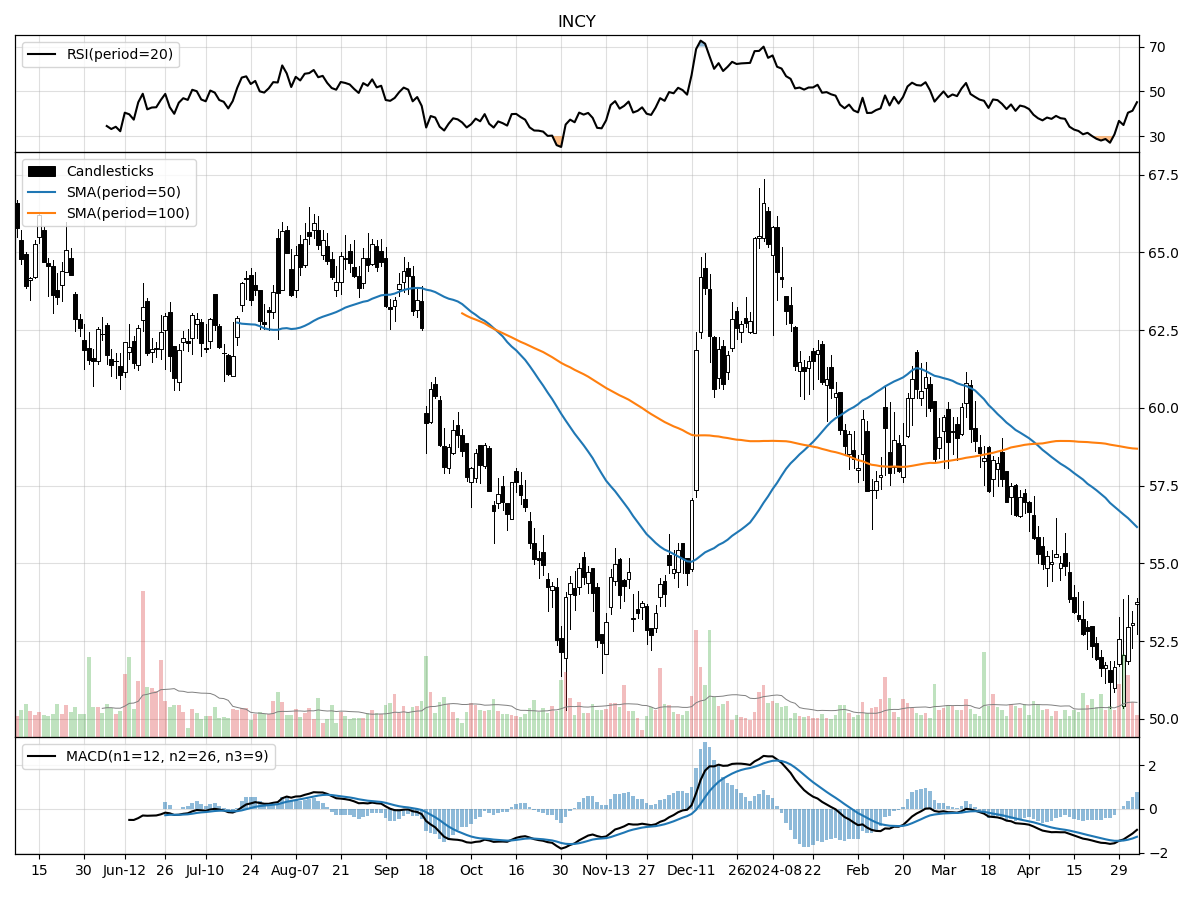Incyte (INCY), Large Cap AI Study of the Week

May 7, 2024
Weekly AI Pick from the S&P 500
Company Overview
Incyte Corporation, a biopharmaceutical company headquartered in Wilmington, Delaware, operates globally with a primary focus on Hematology/Oncology and Inflammation and Autoimmunity. Its flagship product, JAKAFI (ruxolitinib), is a JAK1 and JAK2 inhibitor used to treat myelofibrosis (MF), polycythemia vera (PV), and acute graft-versus-host disease (GVHD), and is protected by patents until at least 2028. JAKAFI is the first FDA-approved JAK inhibitor for these conditions and has been incorporated into the NCCN guidelines due to its demonstrated survival benefits.
MONJUVI, in partnership with MorphoSys AG, was approved by the FDA in July 2020 for relapsed or refractory diffuse large B-cell lymphoma (DLBCL). Incyte will gain full rights to the drug in 2024. PEMAZYRE, Incyte's first internally-developed commercial product, was approved by the FDA in April 2020 to treat cholangiocarcinoma with a specific FGFR2 gene fusion and has since received international approvals.
Incyte has acquired European operations from ARIAD Pharmaceuticals, gaining rights to commercialize Iclusig (ponatinib) for certain leukemias. The company has also entered into a licensing agreement for MacroGenics’ PD-1 inhibitor, retifanlimab, approved for metastatic Merkel cell carcinoma, though it faced regulatory challenges in the US and Europe. Incyte is exploring new therapies and combinations, including a new formulation of ruxolitinib for myelofibrosis and other conditions, and is collaborating with Syndax Pharmaceuticals on axatilimab for chronic GVHD.
The company's pipeline includes pemigatinib for various cancers, with promising trial results leading to Breakthrough Therapy designation for certain myeloid/lymphoid neoplasms. Incyte's oral PD-L1 program is progressing, with compounds INCB99280 and INCB99318 showing early potential. OPZELURA, a topical cream with ruxolitinib, has been FDA-approved for atopic dermatitis and vitiligo and is being expanded into new dermatological indications, potentially driving revenue growth. Povorcitinib, an oral JAK1 inhibitor, is also showing promise in Phase 2b trials for several skin conditions. Incyte continues to advance its clinical programs and has received European approval for OPZELURA in vitiligo, further expanding its international market presence.
By the Numbers
Annual 10-K Report for 2023:
- Net income: $597.6 million (up from $340.7 million in 2022)
- Total revenues: $3.695 billion (up from $3.394 billion in 2022)
- Cost of product revenues: $255 million (increase due to higher sales and inventory reserves)
- Research and development expenses: $1.627 billion (modest rise attributed to more development staff and investment in late-stage assets)
- Selling, general, and administrative expenses: $1,161.3 million (growth driven by expanded workforce and marketing efforts for OPZELURA)
- Loss from changes in fair value of acquisition-related contingent consideration: $29.2 million (largely affected by exchange rate fluctuations)
- Interest income: $172.3 million (significant boost benefiting from higher interest rates)
- Cash, cash equivalents, and marketable securities: $3.7 billion
Quarterly 10-Q Report for Q1 2024:
- JAKAFI's patient population in the U.S.: Estimated 16,000 to 18,500 patients with myelofibrosis
- JAKAFI's market share: 80%-90% classified as intermediate and high-risk
- JAKAFI's patent exclusivity: Extended until 2028 due to pediatric exclusivity
- Estimated new cases annually in the U.S. and EU for ICLUSIG's target conditions: 10,000 to 14,000
Stock Performance and Technical Analysis

Firstly, the stock's current price being 5 percent above its 52-week low and 19 percent below its 52-week high suggests that it may currently be closer to a support level than a resistance level. This could be seen as a potential buying opportunity for investors who believe the stock is likely to rebound, as it indicates the stock isn't overextended on the upside. However, the stock being under moderate selling pressure as indicated by Money Flow indicators suggests that there might be more sellers than buyers in the market right now. This could be contributing to the distribution phase, where the stock could be transitioning from ownership mostly by institutional investors to retail investors, often preceding a downtrend.
The Moving Average Convergence Divergence (MACD) is another momentum indicator that shows the relationship between two moving averages of the stock's price. A bearish MACD at -1.27 indicates that the short-term momentum is weaker than the long-term momentum, signaling that it may not be the optimal time to buy for those looking for immediate upward price action. This bearish signal, when considered with the stock's recent stable price over the last month and a 6.28% decline over the last three months, suggests that the stock may have some downward pressure or at best may move sideways in the near term.
In conclusion, the technical indicators suggest that the stock is under some selling pressure with a bearish trend in the short term as indicated by the MACD. Investors considering this stock should weigh these indicators against their investment strategy and risk tolerance. Those with a longer-term perspective might find the proximity to the 52-week low attractive, hoping for a reversal, while short-term traders might be more cautious due to the current selling pressure and bearish momentum. It's also essential to consider the overall market sentiment and any fundamental changes in the company's outlook, which could influence the stock's performance contrary to what the technical indicators suggest.

The ‘Bull’ Perspective
Summary:
- Robust Revenue Growth: Incyte's flagship product, JAKAFI, continues to dominate the market with an expanding patient population, contributing significantly to a steady revenue stream.
- Diversified Product Portfolio: Incyte's diverse portfolio, including FDA-approved drugs like tafasitamab and pemigatinib, and promising pipeline candidates, positions the company for sustained growth.
- Strategic Partnerships and Market Expansion: Strategic collaborations with Novartis and other entities amplify Incyte's global reach and bolster its market presence.
- Strong Financials Amid Market Volatility: Despite market swings and increased volatility, Incyte's financial health remains robust, with a strong balance sheet and investment in R&D.
- Navigating Risks Effectively: Incyte is proactive in addressing industry risks, from regulatory compliance to competition, ensuring long-term sustainability and profitability.
Elaborating on the Bullish Case for Incyte Corporation:
- Robust Revenue Growth:
Incyte's financial backbone is its JAK inhibitor, JAKAFI, with a patient population in the U.S. estimated at 16,000 to 18,500 for myelofibrosis alone. The drug's expansion into chronic GVHD has opened up new revenue channels, with the pediatric exclusivity extending its patent life until 2028. This strategic extension not only secures Incyte's revenue stream but also enhances the drug's lifecycle, mitigating risks associated with patent cliffs. Incyte’s revenue from JAKAFI, which has shown a consistent year-over-year increase, demonstrates the company's ability to maintain and grow its primary income source despite market turbulence and competitive pressures. - Diversified Product Portfolio:
Incyte's product diversification strategy is a key driver of its resilience. With tafasitamab and pemigatinib gaining FDA and EU approvals, the company is tapping into new markets and therapeutic areas. These approvals, based on solid clinical outcomes, represent significant milestones in Incyte's growth trajectory. The pipeline's depth, including retifanlimab for MCC and ruxolitinib in new formulations, provides multiple avenues for future revenue. The company's commitment to investing in R&D, which has consistently been a substantial percentage of its revenue, is a testament to its dedication to innovation and future growth. - Strategic Partnerships and Market Expansion:
Incyte's partnership with Novartis for the marketing of JAKAFI outside the U.S. exemplifies its strategic approach to global expansion. This collaboration has not only enhanced Incyte's international footprint but also diversified its revenue sources, insulating the company from region-specific economic downturns. The strategic alliances also provide Incyte with a platform to leverage its partners' resources, including sales and distribution networks, which are crucial for scaling up operations without proportionally increasing expenses. - Strong Financials Amid Market Volatility:
In the face of recent market volatility, Incyte has demonstrated financial fortitude. The company's balance sheet remains strong, with a healthy cash reserve that supports ongoing operations and strategic investments. Despite the shifts in Fed policy and the broader economic landscape, Incyte's financial performance has been resilient, with consistent earnings growth underpinning investor confidence. The company's valuation, while reflective of its growth prospects, remains grounded in its solid earnings foundation, suggesting that the stock is not overextended even as market leadership broadens. - Navigating Risks Effectively:
Incyte's proactive risk management strategy is a cornerstone of its stability. The company has successfully navigated the complex regulatory environment, ensuring compliance and maintaining its products' market approvals. In the face of industry-wide challenges such as price pressures and competition, Incyte has shown adaptability, whether through pricing strategies or by staying ahead of the innovation curve. The company's vigilance in monitoring safety profiles and managing product liability risks further underlines its commitment to safeguarding its market position and reputation.
Conclusion:
Incyte Corporation stands out as a compelling investment opportunity within the biopharmaceutical sector. With a strong revenue-generating flagship product, a diversified portfolio, strategic partnerships, resilient financials, and effective risk management, Incyte is well-positioned to weather market uncertainties and deliver long-term value to shareholders. Investors looking for a robust growth story combined with prudent risk oversight would do well to consider Incyte as a key addition to their portfolios.

The ‘Bear’ Perspective
Summary:
- Overreliance on JAKAFI: Incyte's financial health is critically dependent on JAKAFI, which faces stiff competition and patent expiration concerns.
- Regulatory and Reimbursement Hurdles: Government cost management efforts and complex reimbursement processes pose significant risks to profitability.
- Market Saturation and Competition: Incyte must contend with larger pharmaceutical companies and the looming threat of generic drugs eroding market share.
- Operational and Compliance Risks: Incyte's reliance on a few specialty pharmacies and wholesalers, along with strict regulatory compliance requirements, adds operational vulnerability.
- Drug Development Uncertainty: The inherent risks and costs associated with drug development, coupled with potential healthcare reforms, could negatively impact future growth.
Elaboration on Points:
- Overreliance on JAKAFI:
Incyte Corporation's financial stability is heavily reliant on the performance of its flagship product, JAKAFI. While JAKAFI has been successful, contributing to a significant portion of Incyte's revenue, this dependence places the company at risk. The drug's patents are expected to expire in 2028, after which generic competition could drastically reduce its market share. As of now, JAKAFI faces competition from other therapies, and any new market entrants could further threaten its dominance. The drug's sales are also vulnerable to changes in healthcare practices, insurance coverage, and regulatory environments, making its future revenue streams uncertain. - Regulatory and Reimbursement Hurdles:
Incyte's profitability is at risk due to aggressive cost management efforts by governments and third-party payors. These entities are increasingly pushing for lower drug prices and reimbursement rates, which could directly impact Incyte's bottom line. The company must also navigate complex international reimbursement processes, which vary widely by country and can significantly delay or reduce revenue from new drugs. Changes in the US insurance industry, such as consolidation, could lead to pricing pressures and limit Incyte's bargaining power. - Market Saturation and Competition:
The pharmaceutical industry is characterized by intense competition, and Incyte is up against larger companies with more resources for research, marketing, and sales. These competitors could develop new treatments that are more effective or less expensive than Incyte's products. Additionally, the potential for generic versions of JAKAFI and other drugs poses a substantial threat to Incyte's market share and pricing power, which could lead to a decline in sales and profitability. - Operational and Compliance Risks:
Incyte relies on a small number of specialty pharmacies and wholesalers for a major part of its sales, which exposes the company to significant operational risks. Any changes in the participation of these entities could disrupt Incyte's distribution channels. Moreover, the pharmaceutical industry is subject to stringent regulatory compliance. Any failure to adhere to these regulations could result in penalties, loss of market approval, or damage to the company's reputation, all of which would be detrimental to its financial condition. - Drug Development Uncertainty:
The process of drug discovery, development, and commercialization is fraught with risk and uncertainty. Incyte's future growth is contingent upon its pipeline of new drugs, which requires significant investment and faces the possibility of trial failures or regulatory rejections. For example, setbacks such as the FDA's response to OLUMIANT and ruxolitinib extended-release tablets highlight the unpredictable nature of drug approvals. Furthermore, healthcare reforms like the American Rescue Plan Act of 2021 and the Inflation Reduction Act of 2022 could introduce new challenges in drug pricing and reimbursement, potentially affecting Incyte's profitability and growth prospects.
In conclusion, while Incyte Corporation has experienced success with its product portfolio, the risks outlined above suggest a cautious approach to investing in the company's stock. The combination of overreliance on a single product, regulatory and reimbursement challenges, competitive pressures, operational risks, and the uncertainties of drug development create a landscape where the potential for negative impacts on Incyte's financial performance is substantial. Investors should carefully weigh these factors against their investment objectives and risk tolerance before considering a position in Incyte Corporation.




Comments ()